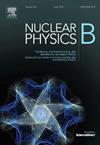对称封装II:封装子空间、封装纠缠和分类
IF 2.8
3区 物理与天体物理
Q2 PHYSICS, PARTICLES & FIELDS
引用次数: 0
摘要
对称封装是一种现象,即在粒子产生时,所有内部量子数(iqn)都被锁定在规范群的单个不可约表示(irp)块中,这是局部性和规范不变性所要求的。由此产生的封装量子态表现出特有的对称约束和纠缠模式。我们建立了一个群论框架来描述各种具体对称的对称包并对相应的包态进行分类:(1)证明了对于任何有限或紧群G,存在G相关的包子空间,其中每个向量都是自动的包态。特别是,在多粒子系统中,G的任何非平凡表示都会引起不可分割的封装纠缠,将所有iqn锁定在一起。(2)将该框架应用于有限群(循环群ZN、电荷共轭C、费米子宇称、宇称P、时间反转T和二面体群)、紧群(U(1)、SU(N)、SU(2)和SU(3))、P形对称和杂化对称中的对称封装。在每种情况下,规范不变性和超选择规则都禁止对结果状态进行因式分解。我们说明了贝尔型封装纠缠态、颜色约束和混合规范不变构型是如何自然产生的。这些结果产生了封装量子态的完整分类。(3)最后,我们将封装原理扩展到包含全时空对称性和局部、全局和洛伦兹/庞卡罗莱电荷的混合系统。我们的方法统一了群论、规范论和拓扑分类的工具。这些结果可能对高能物理、量子场论和量子技术的潜在应用有帮助。本文章由计算机程序翻译,如有差异,请以英文原文为准。
Symmetry packaging II: Packaged subspaces, packaged entanglement, and classification
Symmetry packaging is the phenomenon whereby, upon particle creation, all the internal quantum numbers (IQNs) become locked into a single irreducible representation (irrep) block of the gauge group, as required by locality and gauge invariance. The resulting packaged quantum states exhibit characteristic symmetry constraints and entanglement patterns. We develop a group-theoretic framework to describe the symmetry packaging for a variety of concrete symmetries and to classify the corresponding packaged states:
(1) We prove that for any finite or compact group G, there exist G-associated packaged subspaces, in which every vector is automatically a packaged state. In particular, in multi-particle systems, any nontrivial representation of G induces inseparable packaged entanglement that locks together all IQNs.
(2) We apply this framework to symmetry packaging in finite groups (cyclic group , charge conjugation C, fermion parity, parity P, time reversal T, and dihedral groups), compact groups (, , , and ), p-form symmetries, and hybrid symmetries. In each case, gauge invariance and superselection rules forbid the factorization of the resulting states. We illustrate how Bell-type packaged entangled states, color confinement, and hybrid gauge-invariant configurations all arise naturally. These results yield a complete classification of packaged quantum states.
(3) Finally, we extend the packaging principle to incorporate full spacetime symmetry and hybrid systems of local, global, and Lorentz/Poincaré charges.
Our approach unifies tools from group theory, gauge theory, and topological classification. These results may be useful for potential applications in high energy physics, quantum field theory, and quantum technologies.
求助全文
通过发布文献求助,成功后即可免费获取论文全文。
去求助
来源期刊

Nuclear Physics B
物理-物理:粒子与场物理
CiteScore
5.50
自引率
7.10%
发文量
302
审稿时长
1 months
期刊介绍:
Nuclear Physics B focuses on the domain of high energy physics, quantum field theory, statistical systems, and mathematical physics, and includes four main sections: high energy physics - phenomenology, high energy physics - theory, high energy physics - experiment, and quantum field theory, statistical systems, and mathematical physics. The emphasis is on original research papers (Frontiers Articles or Full Length Articles), but Review Articles are also welcome.
 求助内容:
求助内容: 应助结果提醒方式:
应助结果提醒方式:


